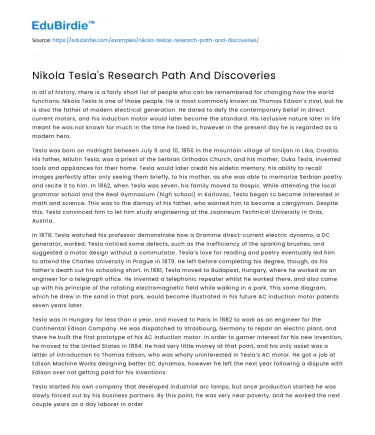In all of history, there is a fairly short list of people who can be remembered for changing how the world functions. Nikola Tesla is one of those people. He is most commonly known as Thomas Edison’s rival, but he is also the father of modern electrical generation. He dared to defy the contemporary belief in direct current motors, and his induction motor would later become the standard. His reclusive nature later in life meant he was not known for much in the time he lived in, however in the present day he is regarded as a modern hero.
Tesla was born on midnight between July 9 and 10, 1856 in the mountain village of Smiljan in Lika, Croatia. His father, Milutin Tesla, was a priest of the Serbian Orthodox Church, and his mother, Duka Tesla, invented tools and appliances for their home. Tesla would later credit his eidetic memory, his ability to recall images perfectly after only seeing them briefly, to his mother, as she was able to memorize Serbian poetry and recite it to him. In 1862, when Tesla was seven, his family moved to Gospic. While attending the local grammar school and the Real Gymnasium (high school) in Karlovac, Tesla began to become interested in math and science. This was to the dismay of his father, who wanted him to become a clergyman. Despite this, Tesla convinced him to let him study engineering at the Joanneum Technical University in Graz, Austria.
Save your time!
We can take care of your essay
- Proper editing and formatting
- Free revision, title page, and bibliography
- Flexible prices and money-back guarantee
In 1878, Tesla watched his professor demonstrate how a Gramme direct-current electric dynamo, a DC generator, worked. Tesla noticed some defects, such as the inefficiency of the sparking brushes, and suggested a motor design without a commutator. Tesla’s love for reading and poetry eventually led him to attend the Charles University in Prague in 1879. He left before completing his degree, though, as his father’s death cut his schooling short. In 1881, Tesla moved to Budapest, Hungary, where he worked as an engineer for a telegraph office. He invented a telephonic repeater whilst he worked there, and also came up with his principle of the rotating electromagnetic field while walking in a park. This same diagram, which he drew in the sand in that park, would become illustrated in his future AC induction motor patents seven years later.
Tesla was in Hungary for less than a year, and moved to Paris in 1882 to work as an engineer for the Continental Edison Company. He was dispatched to Strasbourg, Germany to repair an electric plant, and there he built the first prototype of his AC induction motor. In order to garner interest for his new invention, he moved to the United States in 1884. He had very little money at that point, and his only asset was a letter of introduction to Thomas Edison, who was wholly uninterested in Tesla’s AC motor. He got a job at Edison Machine Works designing better DC dynamos, however he left the next year following a dispute with Edison over not getting paid for his inventions.
Tesla started his own company that developed industrial arc lamps, but once production started he was slowly forced out by his business partners. By this point, he was very near poverty, and he worked the next couple years as a day laborer in order to get by. In 1887, he managed to save enough money for his own laboratory, and started the Tesla Electric Company, which was backed by the Western Union Telegraph Company. Here, he finally began to explore and develop his AC electric motor.
In 1888, Tesla filed complicated patents for every one of his AC dynamos, motors, and transformers, as well as many other aspects of his alternating-current






 Stuck on your essay?
Stuck on your essay?

